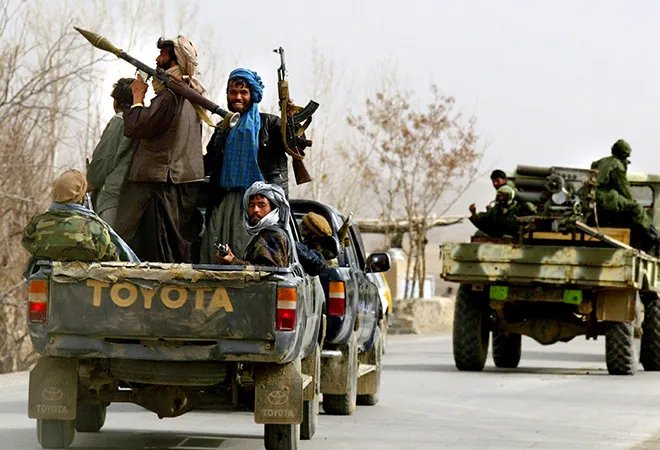The 26th report of the United Nations Analytical Support and Sanctions Monitoring Team, published on 23 July 2020, showed that over 6,000 Pakistani insurgents remain in hiding in Afghanistan. The report claimed most of them to be members of the outlawed Tehreek-i-Taliban Pakistan (TTP) militant group, which is known for targeting the Pakistan military as well as the civilian population.
Further, the report said that TTP fighters in Afghanistan are closely associated with the Islamic State affiliate in the country, more commonly known as the Islamic State – Khorasan Province (ISKP), which is based in the eastern part of the country. Although ISKP stands weakened in the face of an assertive Afghan military campaign, it retains the capability of launching large-scale high profile attacks in Afghanistan, states the report. Some of the major attacks conducted by the group, soon after the signing of the US-Taliban agreement, include the indirect firing at President Ashraf Ghani’s swearing in ceremony in Kabul on 9 March, the attack on a gurudwara in Kabul, and that on a funeral procession in Nangarhar Province.
As per the report, Al-Qaeda too remains active in at least 12 provinces in Afghanistan, with an estimated strength of 400–600 fighters. The group reportedly maintains close contact with the Haqqani Network (HQN), a group that pledges allegiance to the Afghan Taliban but maintains independent command and control, and lines of operation, out of North Waziristan in Pakistan. The HQN takes care of the Taliban’s bidding in the Loya Paktia region of Afghanistan, while also covertly playing the role of a proxy force for Pakistan, to represent the latter’s strategic interests Afghanistan.
There also exist a number of Central Asian and Uighur insurgents in Afghanistan, belonging mainly to the Islamic Movement of Uzbekistan (IMU) operational predominantly in Faryab Province, the Islamic Jihad Group (IJU) -- a splinter group of the IMU, and the East Turkestan Islamic Movement (ETIM), which is active in the Takhar, Kunduz and Badakhshan Provinces. The reportedly extensive presence of foreign fighters presents a serious challenge in securing counterterrorism gains of the past, while ensuring that the Taliban delivers on the promise of ensuring non-use of Afghan soil to plan attacks against the US or its allies.
Dangerous asymmetry
The US-Taliban agreement, signed on 29 February 2020, laid down the conditions for a phased withdrawal of foreign troops from Afghanistan, to be completed by mid-2021. The fundamental conditions for the withdrawal included Taliban guarantees to ensure non-use of Afghan soil by any entity to devise attacks against the US or its allies, and the start of intra-Afghan talks within a stipulated time frame. While the signing of the agreement and consequent chain of events has brought the US closer than its ever been to ending its two decades-long military campaign in Afghanistan, the success of the deal hinges on the will of the Taliban more than the US would like to admit.
The deal, in a sense, puts the onus of ensuring US counter-terrorism interests on the Taliban itself, making it the principal guarantor of US strategic objectives in Afghanistan – ironical indeed. As the US continues to retreat militarily, the Taliban will presumably feel less and less obligated to hold up their end of the bargain, rendering the security situation in Afghanistan susceptible to compounded conflict. Not to forget, the Taliban had made similar counterterrorism assurances to the US vis-à-vis the Al-Qaeda, just prior to the catastrophic episode of 9/11.
Despite Taliban assurances to the US in keeping with the deal, there are reports of HQN hardliners that form the lethal military arm of the Taliban, strengthening their tactical alliances with the ISKP and Lashkar-e-Taiba (LeT), in an effort to disrupt the peace process and continue the fight. While the HQN remains under the larger Taliban apparatus and pledges allegiance to Taliban chief Mullah Haibatullah Akhundzada, it operates independent of the Taliban and in the process, arguably grants the latter a considerable degree of plausible deniability, at least on paper. As per intelligence reports received by the Indian security apparatus, the Taliban has joined hands with the Lashkar-e-Taiba(LeT), as well as the Jaish-e-Mohammad (JeM), to carry out operations in the Kunar – Paktiya – Paktika – Nuristan - Khost region, and Nangarhar - Kandahar - Helmand provinces in Afghanistan, respectively.
The Taliban also maintains steady contact with the Al-Qaeda, and it would be a great folly to assume otherwise, given that the two groups share the same Islamic ideology that forms the basis of their collective fight against the West. The Taliban can therefore be expected to refrain from abandoning their association with the Al-Qaeda, in so far as it continues to benefit the Taliban operationally, and Al-Qaeda activities are not traced back to the Taliban.
The US-Taliban deal falls remarkably short of providing a sustainable and fool-proof mechanism for ensuring delivery on commitments made by the insurgent group, with the text only mentioning unspecified “enforcement mechanisms” for implementation. One obvious limitation in implementing the agreement would be the complex task of ascertaining the Taliban’s compliance with its counterterrorism commitments, compared to the easily determinable retreat of uniformed foreign forces from Afghanistan.
The inability or unwillingness of the Taliban to sever ties with other militant groups brings out its vulnerable disposition to possibilities of internal revolt, as Taliban cadres identify deeply with the common cause that binds them all. Moreover, the continuing violence despite explicit commitments to talks with the Afghan government arguably indicates a lack of intra-Taliban consensus on negotiating peace.
However, whether the Taliban becomes visibly divided over talks or not, intensified conflict would be guaranteed in both circumstances. Worse still, if the emerging and strengthening links between the Taliban and foreign terrorist groups remained unchecked, enduring peace would also remain a far-fetched proposition in Afghanistan.
This commentary originally appeared in South Asia Weekly.
The views expressed above belong to the author(s). ORF research and analyses now available on Telegram! Click here to access our curated content — blogs, longforms and interviews.




 PREV
PREV


